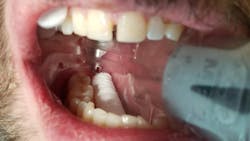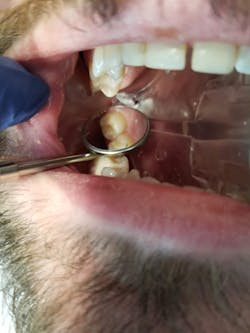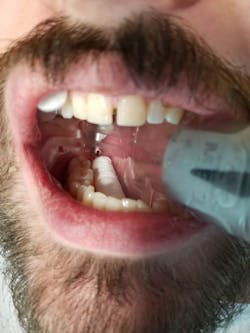Why not do six-handed dentistry all the time?
As a general dentist, I am always concerned about achieving proper isolation for my dental restorations so that they will last as long as possible. My dental assistant is always busy getting ready for the next step in the procedure: preparing the materials that have to be mixed, passing the next instrument, or wiping my instrument down so that I can have a seamless interaction with patients while they’re in the dental chair. I want to share with my fellow colleagues, dental students, and schools how six-handed dentistry is possible all the time, without a third person around the dental chair.
This brought me to Zyris Smiles and their isolation system. Zyris offers Isolite, Isodry, and Isovac. I decided to give it a shot, and what a life changer! I purchased Isodry because I became accustomed to the light on my loupes.
Isodry is a mouthpiece that gets attached to the high-volume evacuation (HVE) system after an adapter has been installed on the hose. The mouthpiece allows suction and retraction. Retraction takes care of the tongue and cheek at the same time.
Isodry comes in several sizes to accommodate every individual. In my office, we use the medium-size mouthpiece 85% of the time and the small or pedo-size for children. Choosing the right size is critical. If your patient is able to open wide without any effort, the mouthpiece will constantly move and not stay in the ideal place.
The best way to determine your patient’s opening range is by using fingers from upper to lower incisal edge as a gauge. Three or fewer fingers indicates the medium size for an adult; for children, just choose the small or pediatric size depending on the child.
Patients may experience feelings of claustrophobia if you do not describe the isolation procedure before inserting the mouthpiece. What you tell the patient is key to success. This is the process I use, and it works every time—even with my phobic patients, uneasy patients, and children.
My procedure for using Isodry
- Step 1: I show the patient the mouthpiece.
- Step 2: I tell the patient: “It's harder for me to place this in your mouth than it is for me to remove it. If you need to take it out, just let me know and I can remove it in no time.” I think reassuring statements like this help the patient feel more in control of the experience.
- Step 3: I ask the patient to open as wide as possible so the mouthpiece can be inserted without interference. I position it in the right place and ask the patient to slowly bite down while I make sure that the lips are safe.
- Step 4: I ask the patient if he or she is comfortable. Then, before I turn the mouthpiece on, I explain that they will hear a noise when the suction is turned on.
Isodry offers a pair of hands by retracting the tongue and cheek, which gives me better visibility, a controlled environment, and a drier area to work on. My other pair of hands is my wonderful dental assistant, who doesn’t have to worry about retraction. Instead, she can focus on the next steps and any additional suction that might be needed as well as making sure my mirror is as clean as possible while I’m working on the upper arch. The final pair of hands are mine—the dentist who makes everything happen in a timely and precise manner.
Long-term success of each restoration is the goal, and it can be realized with all of these helping hands. Six-handed dentistry is the best way to perform good dentistry in a safe and dry manner.Helpful hints
Sometimes a cotton roll might be needed on the floor of the mouth or the upper vestibule area to get 100% isolation. If the area is extremely dry, use water to avoid friction burn from the plastic attaching to the buccal mucosa. Make sure the retromolar pad and maxillary tuberosity are incorporated to seal the area better. Have the saliva ejector ready to use once the mouthpiece comes out of the mouth. To avoid saliva and water going everywhere, don't turn the suction off until it's out of the mouth and back in the holding rack.
All photos courtesy of the author.
Editor’s note: This article first appeared in Through the Loupes newsletter, a publication of the Endeavor Business Media Dental Group. Read more articles at this link and subscribe here.
About the Author

Anabel Curiel-Franciskato, DMD
Anabel Curiel-Franciskato, DMD, began her dental career in 1992 as a certified dental assistant, and she was certified as a dental lab technician in 1997. She attended Tufts University School of Dental Medicine, where she earned her doctorate in dental medicine in 2004. Dr. Curiel-Franciskato has owned a private practice, NorthShore Dentistry, since 2005. She is a former assistant professor at Tufts University and has served in the United States Army Reserve since 2012.



